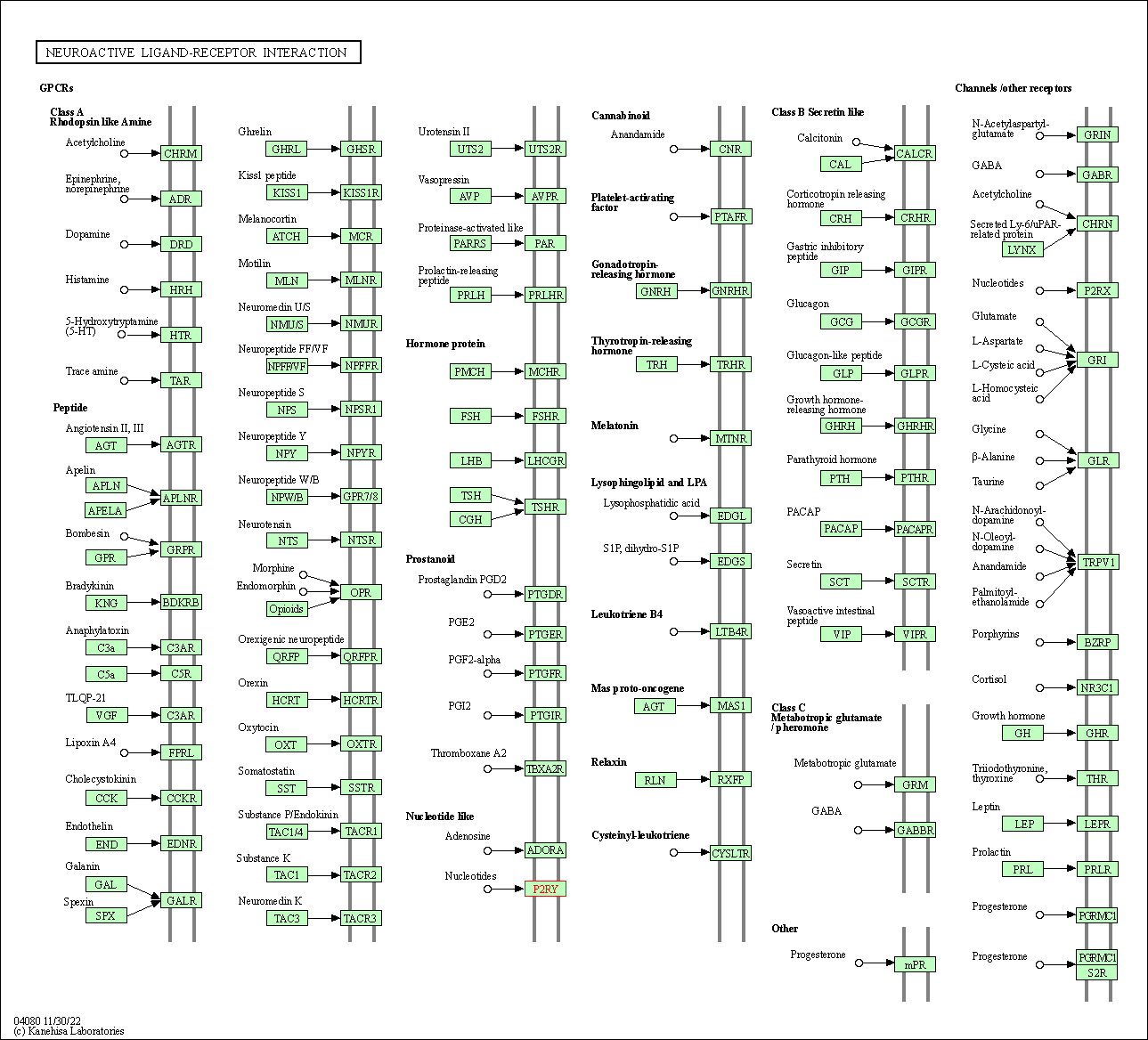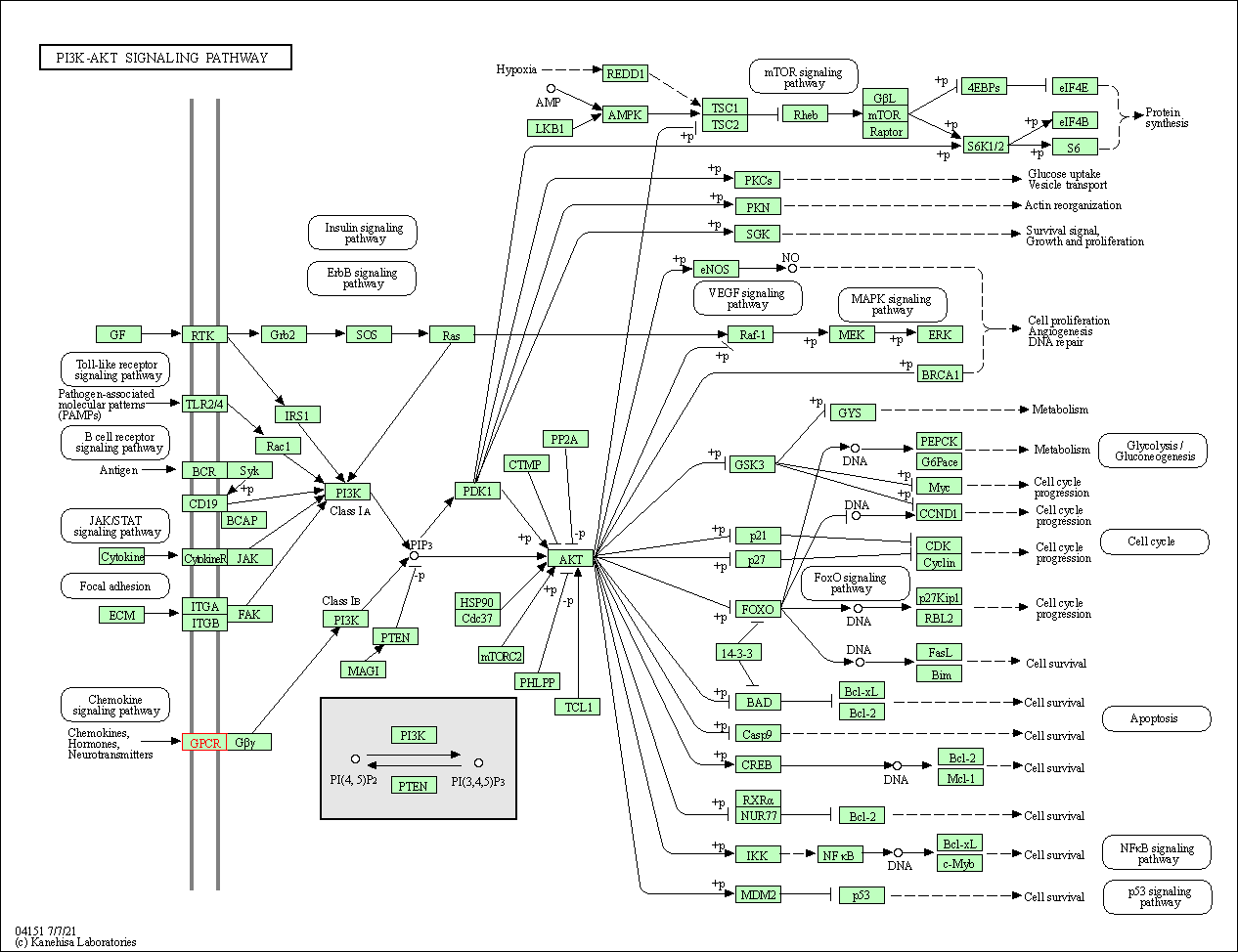Target Information
| Target General Information | Top | |||||
|---|---|---|---|---|---|---|
| Target ID |
T13484
(Former ID: TTDI03358)
|
|||||
| Target Name |
Lysophosphatidic acid receptor 6 (LPAR6)
|
|||||
| Synonyms |
RB intron encoded G-protein coupled receptor; Purinergic receptor 5; P2Y5; P2Y purinoceptor 5; P2RY5; Oleoyl-L-alpha-lysophosphatidic acid receptor; LPA-6; LPA receptor 6
Click to Show/Hide
|
|||||
| Gene Name |
LPAR6
|
|||||
| Target Type |
Literature-reported target
|
[1] | ||||
| Function |
Binds to oleoyl-L-alpha-lysophosphatidic acid (LPA). Intracellular cAMP is involved in the receptor activation. Important for the maintenance of hair growth and texture.
Click to Show/Hide
|
|||||
| UniProt ID | ||||||
| Sequence |
MVSVNSSHCFYNDSFKYTLYGCMFSMVFVLGLISNCVAIYIFICVLKVRNETTTYMINLA
MSDLLFVFTLPFRIFYFTTRNWPFGDLLCKISVMLFYTNMYGSILFLTCISVDRFLAIVY PFKSKTLRTKRNAKIVCTGVWLTVIGGSAPAVFVQSTHSQGNNASEACFENFPEATWKTY LSRIVIFIEIVGFFIPLILNVTCSSMVLKTLTKPVTLSRSKINKTKVLKMIFVHLIIFCF CFVPYNINLILYSLVRTQTFVNCSVVAAVRTMYPITLCIAVSNCCFDPIVYYFTSDTIQN SIKMKNWSVRRSDFRFSEVHGAENFIQHNLQTLKSKIFDNESAA Click to Show/Hide
|
|||||
| 3D Structure | Click to Show 3D Structure of This Target | AlphaFold | ||||
| Cell-based Target Expression Variations | Top | |||||
|---|---|---|---|---|---|---|
| Cell-based Target Expression Variations | ||||||
| Different Human System Profiles of Target | Top |
|---|---|
|
Human Similarity Proteins
of target is determined by comparing the sequence similarity of all human proteins with the target based on BLAST. The similarity proteins for a target are defined as the proteins with E-value < 0.005 and outside the protein families of the target.
A target that has fewer human similarity proteins outside its family is commonly regarded to possess a greater capacity to avoid undesired interactions and thus increase the possibility of finding successful drugs
(Brief Bioinform, 21: 649-662, 2020).
Human Pathway Affiliation
of target is determined by the life-essential pathways provided on KEGG database. The target-affiliated pathways were defined based on the following two criteria (a) the pathways of the studied target should be life-essential for both healthy individuals and patients, and (b) the studied target should occupy an upstream position in the pathways and therefore had the ability to regulate biological function.
Targets involved in a fewer pathways have greater likelihood to be successfully developed, while those associated with more human pathways increase the chance of undesirable interferences with other human processes
(Pharmacol Rev, 58: 259-279, 2006).
Biological Network Descriptors
of target is determined based on a human protein-protein interactions (PPI) network consisting of 9,309 proteins and 52,713 PPIs, which were with a high confidence score of ≥ 0.95 collected from STRING database.
The network properties of targets based on protein-protein interactions (PPIs) have been widely adopted for the assessment of target’s druggability. Proteins with high node degree tend to have a high impact on network function through multiple interactions, while proteins with high betweenness centrality are regarded to be central for communication in interaction networks and regulate the flow of signaling information
(Front Pharmacol, 9, 1245, 2018;
Curr Opin Struct Biol. 44:134-142, 2017).
Human Similarity Proteins
Human Pathway Affiliation
Biological Network Descriptors
|
|
| KEGG Pathway | Pathway ID | Affiliated Target | Pathway Map |
|---|---|---|---|
| Phospholipase D signaling pathway | hsa04072 | Affiliated Target |

|
| Class: Environmental Information Processing => Signal transduction | Pathway Hierarchy | ||
| Neuroactive ligand-receptor interaction | hsa04080 | Affiliated Target |

|
| Class: Environmental Information Processing => Signaling molecules and interaction | Pathway Hierarchy | ||
| PI3K-Akt signaling pathway | hsa04151 | Affiliated Target |

|
| Class: Environmental Information Processing => Signal transduction | Pathway Hierarchy | ||
| Degree | 3 | Degree centrality | 3.22E-04 | Betweenness centrality | 1.64E-06 |
|---|---|---|---|---|---|
| Closeness centrality | 1.63E-01 | Radiality | 1.24E+01 | Clustering coefficient | 0.00E+00 |
| Neighborhood connectivity | 5.33E+00 | Topological coefficient | 6.19E-01 | Eccentricity | 13 |
| Download | Click to Download the Full PPI Network of This Target | ||||
| Chemical Structure based Activity Landscape of Target | Top |
|---|---|
| References | Top | |||||
|---|---|---|---|---|---|---|
| REF 1 | G protein-coupled receptor P2Y5 and its ligand LPA are involved in maintenance of human hair growth. Nat Genet. 2008 Mar;40(3):329-34. | |||||
If You Find Any Error in Data or Bug in Web Service, Please Kindly Report It to Dr. Zhou and Dr. Zhang.

